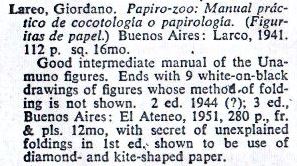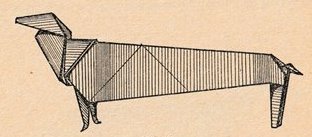The Public Paperfolding History Project Last updated 12/2/2025 x |
||||||||
| Second Edition of Papiro-Zoo: Manual Practico de Papirologia o Cocotologia by Giordano Lareo, 1944 | ||||||||
The second edition of 'Papiro-Zoo: Manual Practico de Papirologia o Cocotologia' by Giordano Lareo was published by Libraria 'El Ateneo' Editorial in Buenos Aires in 1944. This second edition contains the original Prologo but the other introductory material has been replaced by a section headed 'Pajaritas de papel' (see below). All the other material from the first edition is retained with the exception of the 'Figuras varias' drawings at the back of the book, which are omitted. There are diagrams explaining how to fold 8 additional designs (see Analysis below). I have not seen a full copy of this work. The illustrations in the analysis are taken from the third edition, published in 1951, but I believe they are identical in both editions. The text of 'Pajaritas de papel' is similarly taken from the third edition. You can find some details of the 1941 first edition here. You can find full details of the 1951 third edition here. ********** This work is mentioned in Gershon Legman's 'Bibliography of Paperfolding' which was published in 1952.
********** The introductory section, 'Pajaritas de Papel', contains several observations of interest. Firstly, regarding the Spanish words for paperfolding the author says, roughly translated: 'It is not a question of making a fuss about the name papyrology or cocotology, the latter designation being due to its main founder and promoter ... don Miguel de Unamuno, thus Castilianizing ... the French name of the classic paper bird. PAPYRO-ZOO seems to me, however, the most accurate because it almost involves a definition, in effect it is about making paper birds, but in the form of various animals.' Nevertheless, the author uses the word 'papiroflexia' at various points in his introduction. Secondly, the author reiterates the opposition to cutting and glueing found in the Prologo to the first edition. Roughly, 'The fundamental thing in the resolution of this problem is not to cut or paste any part of the paper that is to be used for the construction of the figure. Anything that goes beyond this rule is neither more nor less than cheating. ... The use of scissors or glue not only distorts the art itself but also paperfolding would lose much of its pedagogical value.' The latter part of the introduction is devoted to an explanation of the benefits of using paperfolding in the classroom, including its use to introduce work about the animals themselves and their habitats. The author regards paperfoldfing as an art, roughly, 'yes, a second-rate art, decorative art if you will, but art at last which has a great kinship with sculpture.' After this introduction the work is divided into five parts: First Part - diagrams for a few simple classic designs. (6 designs that because of their simplicity are within reach of children in the first grades.) Second Part - diagrams for designs made from the square (11 designs) Third Part - designs made from rectangular paper (1 design only) Fourth Part - designs made from kite-shaped paper (2 designs) Fifth Part - designs made from rhombic paper (1 design only) **********
**********
**********
********** Analysis Designs which are new to this edition Second Part La Grulla Developed from a bird base
********** El Mono Developed from a bird base. This design only has one back leg.
********** El Tigre Developed from a bird base. This design only has one back leg (and a tail).
********** El Rinoceronte Developed from a bird base. This design only has one back leg.
********** El Nandu (the rhea) Developed from the form shown below, which is half a bird base folded from a right angle isosceles triangle obtained by folding a square in half.
********** Fourth Part The base for these designs is collapsed from a kite-shape like this:
********** El Perro 'Salchicha' This design only has one back leg.
********** El Raton
********** Fifth Part (new) El Caballo This design is developed from a bird base analoque folded from a 60/120 degree rhombus.
********** |
||||||||






















